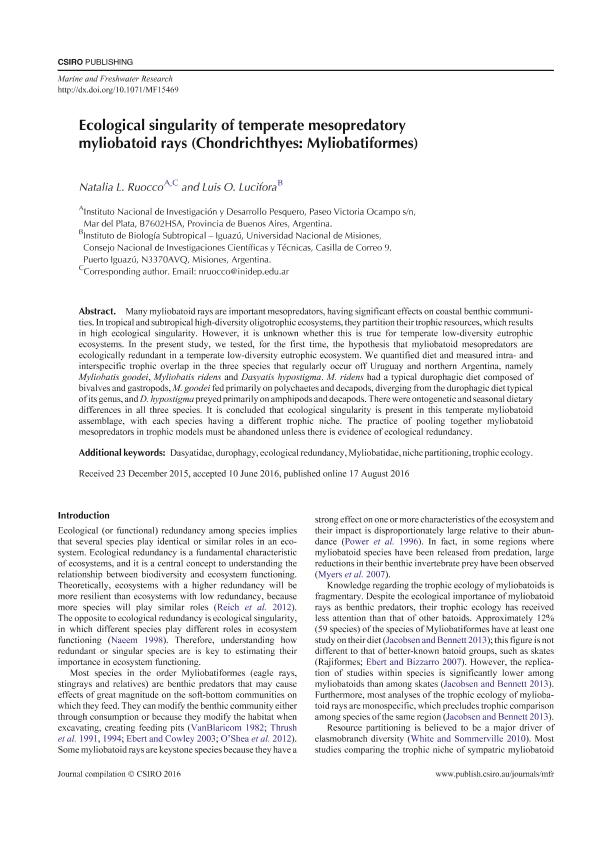Mostrar el registro sencillo del ítem
dc.contributor.author
Ruocco, Natalia Lorena

dc.contributor.author
Lucifora, Luis Omar

dc.date.available
2018-05-21T20:28:59Z
dc.date.issued
2016-06
dc.identifier.citation
Ruocco, Natalia Lorena; Lucifora, Luis Omar; Ecological singularity of temperate mesopredatory myliobatoid rays (Chondrichthyes: Myliobatiformes); Csiro Publishing; Marine and Freshwater Research; 68; 6; 6-2016; 1098-1111
dc.identifier.issn
1323-1650
dc.identifier.uri
http://hdl.handle.net/11336/45827
dc.description.abstract
Many myliobatoid rays are important mesopredators, having significant effects on coastal benthic communities. In tropical and subtropical high-diversity oligotrophic ecosystems, they partition their trophic resources, which results in high ecological singularity. However, it is unknown whether this is true for temperate low-diversity eutrophic ecosystems. In the present study, we tested, for the first time, the hypothesis that myliobatoid mesopredators are ecologically redundant in a temperate low-diversity eutrophic ecosystem. We quantified diet and measured intra- and interspecific trophic overlap in the three species that regularly occur off Uruguay and northern Argentina, namely Myliobatis goodei, Myliobatis ridens and Dasyatis hypostigma. M. ridens had a typical durophagic diet composed of bivalves and gastropods, M. goodei fed primarily on polychaetes and decapods, diverging from the durophagic diet typical of its genus, and D. hypostigma preyed primarily on amphipods and decapods. There were ontogenetic and seasonal dietary differences in all three species. It is concluded that ecological singularity is present in this temperate myliobatoid assemblage, with each species having a different trophic niche. The practice of pooling together myliobatoid mesopredators in trophic models must be abandoned unless there is evidence of ecological redundancy.
dc.format
application/pdf
dc.language.iso
eng
dc.publisher
Csiro Publishing

dc.rights
info:eu-repo/semantics/openAccess
dc.rights.uri
https://creativecommons.org/licenses/by-nc-sa/2.5/ar/
dc.subject
Ecological Redundancy
dc.subject
Niche Partitioning
dc.subject
Myliobatidae
dc.subject
Dasyatidae
dc.subject
Durophagy
dc.subject
Trophic Ecology
dc.subject.classification
Otras Ciencias Biológicas

dc.subject.classification
Ciencias Biológicas

dc.subject.classification
CIENCIAS NATURALES Y EXACTAS

dc.title
Ecological singularity of temperate mesopredatory myliobatoid rays (Chondrichthyes: Myliobatiformes)
dc.type
info:eu-repo/semantics/article
dc.type
info:ar-repo/semantics/artículo
dc.type
info:eu-repo/semantics/publishedVersion
dc.date.updated
2018-05-16T14:44:59Z
dc.identifier.eissn
1323-1650
dc.journal.volume
68
dc.journal.number
6
dc.journal.pagination
1098-1111
dc.journal.pais
Australia

dc.journal.ciudad
Collingwood
dc.description.fil
Fil: Ruocco, Natalia Lorena. Instituto Nacional de Investigaciones y Desarrollo Pesquero; Argentina. Consejo Nacional de Investigaciones Científicas y Técnicas. Centro Científico Tecnológico Conicet - Mar del Plata. Instituto de Investigaciones Marinas y Costeras. Universidad Nacional de Mar del Plata. Facultad de Ciencia Exactas y Naturales. Instituto de Investigaciones Marinas y Costeras; Argentina
dc.description.fil
Fil: Lucifora, Luis Omar. Consejo Nacional de Investigaciones Científicas y Técnicas. Centro Científico Tecnológico Conicet - Nordeste. Instituto de Biología Subtropical. Instituto de Biología Subtropical - Nodo Puerto Iguazú | Universidad Nacional de Misiones. Instituto de Biología Subtropical. Instituto de Biología Subtropical - Nodo Puerto Iguazú; Argentina
dc.journal.title
Marine and Freshwater Research

dc.relation.alternativeid
info:eu-repo/semantics/altIdentifier/url/http://www.publish.csiro.au/paper/MF15469.htm
dc.relation.alternativeid
info:eu-repo/semantics/altIdentifier/doi/http://dx.doi.org/10.1071/MF15469
Archivos asociados
